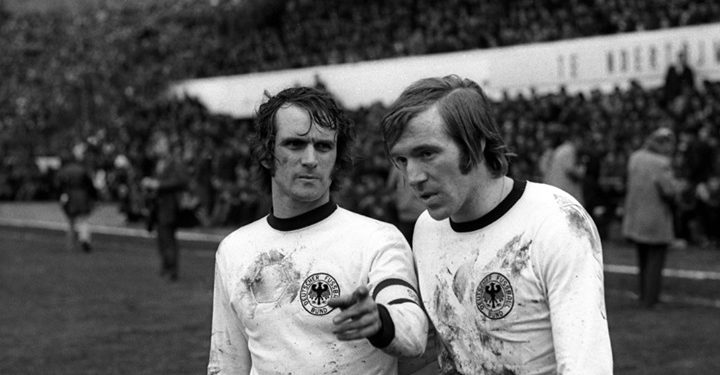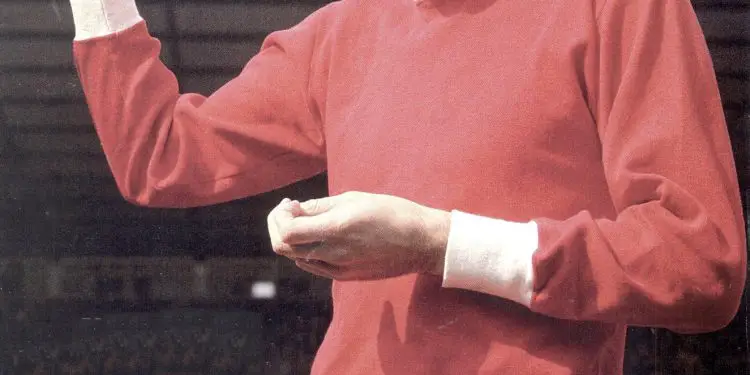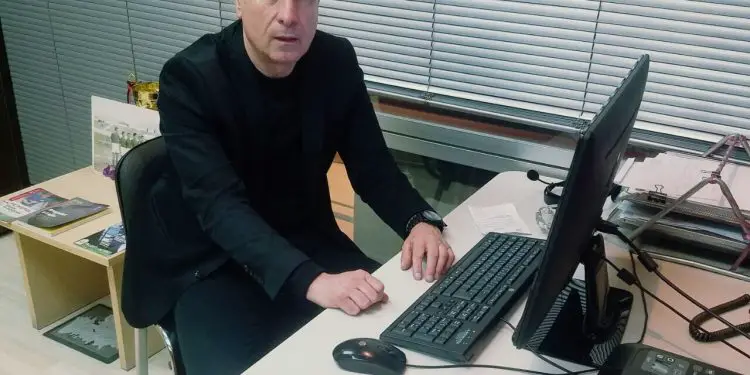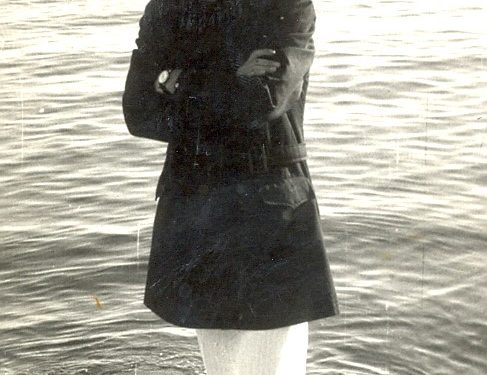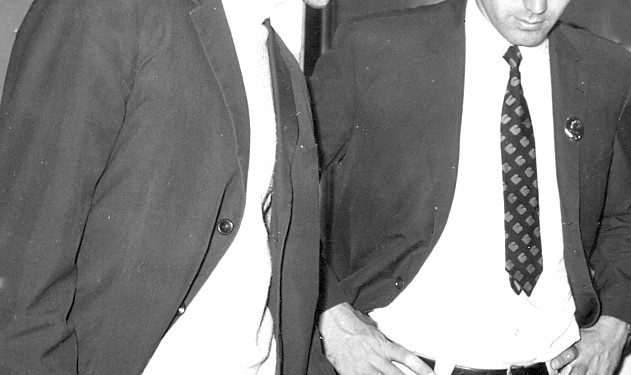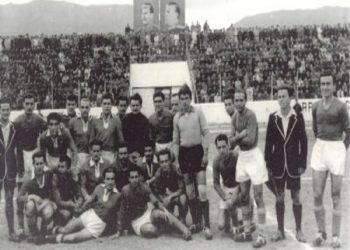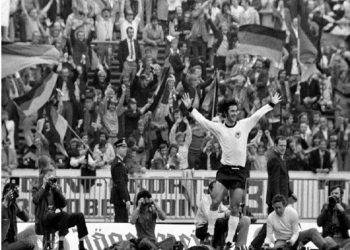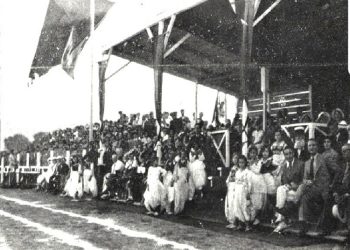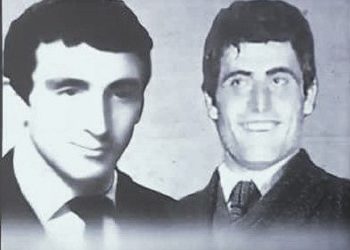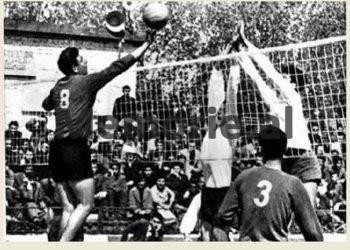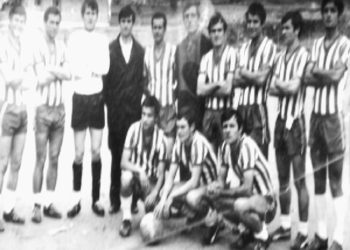From Uvil Zajmi
Memorie.al / Following the fashion in the communist Albania of Enver Hoxha and his successor, Ramiz Alia, has not been easy. The slogan “Let’s fight foreign shows” has accompanied Albanians for decades, an inseparable slogan everywhere and in every sector of life. Warning, persecutor for anyone who showed trends and sought to be modern. In particular, athletes were on the front line, as public people, starting from the fact that the sports environment was tolerant and offered this forbidden opportunity. They were considered a point of reference for fashion, since they went abroad, had contacts with foreigners, appearing with different clothing, appearance, long hair, thick berets, etc., which provoked.
Until 1973, June, when after Enver Hoxha’s speech in the 4th Plenum, the dictatorship reappeared more ferocious than ever. No fads, no demos or imitations. “Foreign show”, it was called and had to be punished in all ways and forms. No long hair, no sideburns, no beard, no moustache. The neighborhood, school, company, department, institution, military department, etc. stopped, criticized.
A detail, opinion, orientation was enough to follow public criticism, with lightning sheets in the foreground, newspapers, youth groups, party organization, Democratic Front, Professional Unions, War Veterans organization, Sports Club, etc. This also applies to sportsmen, any, known, master, champion, leader, it was forbidden to demonstrate fashion, even more so to imitate foreigners, in appearance and gestures. In sports facilities, it was the Club, even the referee, if he found “foreign performances”, stopped playing.
But how did Albanian sportsmen transmit fashion? From the attendance of the girls of the Sports Palace, the love affairs, the modern clothes, that way of behavior was then considered inappropriate and should be punished. The big contrast when foreign teams came to Tirana, from European football legends like; Best, Netzer, Overat, in the Yugoslav team “Jugosplastika”, the beard of “Sëltik” of Glasgow and how Genci Tomori remembers today, that time, the vicissitudes of the desire for a little more hair:
“I was cut in the dressing room. Ali Kastrati was also back as our barber”, the well-known former player of “Partizan” and the National Team confesses today.
GEORGE BEST AND “BEATLESMANIA”
The fashion followed by athletes, mainly footballers, in the sports world has been a great preference for them, but also for others who followed and imitated them. Both on the field and off it, where brilliance shone, modern style in clothing, up to famous loves.
The first shows of a fashion different from the players were seen when the famous George Best came out on the field with long hair, with a “look” never seen before, imitating the famous English music group “Beatles”, after to which “bestomania” took massive spread in the middle of the 65s. The Northern Irishman even came to Tirana, in the 1965 match, in the Albania-Northern Ireland match, 1-1.
This is the period that can be considered as the one that footballers, at least, were seen in the fields, public environments with a new style, especially with hair above the ears and thick bassets. Mainly in Northern European countries, English, Dutch clubs, then going down to the Central one with West Germany at the top, in France, Italy, Spain, Yugoslavia, etc. Much less so in Eastern Bloc countries. What about in Albania?
THE 70’S, WHEN THE TREND HAD ITS PEAK
The desire to imitate the West in this direction was also great and “bestomania” had its effects on Albanian athletes as well. Trends begin and you see football players, basketball players, volleyball players, etc., with a tendency to wear hair, a slightly different “look”. Mostly those who went out had contact with football beyond the borders, the Western one, where the sportsmen’s fashion was without limits, they were certainly more influenced, privileged and who demonstrated it.
Albanian sport inherited this tradition, when great players were also passionate about fashion, and many sportsmen did not miss the appearance of this trend, at least until the 60s, hair with brilliants, elegant clothes, frequenting bars main, but also with known love. One of them, Zihni Gjinali, the outstanding football player-coach, who did not share his brilliance, even when he played in the match. So, it was the athletes, more like public people, who were the first to convey any change. This, also from the emergence of teams, clubs, communication in particular with the Western world, had a great impact, not only on the sports quality, but also in relation to a desire, aesthetics, different, modern clothing.
The confrontations with Best, Netzer, Beckenbauer, Overat, Myler, Krujf, Shollman, Kapicic, have been an incentive. The arrival of teams from ‘Norçeping’, ‘Cologne’, ‘Klilmarnok’, Futboll-Club ‘Torino’, ‘Standart’, ‘Ajax’, or national teams, such as; Denmark, Holland, Switzerland, Yugoslavia, West and East Germany, or in hand games, from ‘Virtus’, ‘Bloker’, ‘Oransoda’, ‘Jugosplastika’, ‘Panathinaikos’, ‘Cervena Zvezda’, ‘Partizani’ Belgrade , etc., in the spectacular challenges of the time, had an impact when you saw in front of you caliber players who, in addition to greatness on the floor, also in aesthetics, with the attractive “look” they transmitted.
HOW DO THE ATHLETES BRING, CONVEY AND DEMONSTRATE FASHION?!
The 70s were accompanied by mass travel to the People’s Republic of China. Otherwise it was a match in the West. Only three days, but in that total censorship, athletes and artists were the only ones who had that opportunity to go out, and to bring something from there, especially in clothing. Although the customs control did not allow foreign currency to be taken out nor to bring outside the norms, even though they were stopped, controlled, risking and being punished, they were not able to stop them.
Athletes made a difference, stood out when they went out, stayed in friendship, the Western preference was evident. A pair of shoes, a jacket, a shirt, an overcoat, even on the beach, public places, tours, the ones who caught the eye the most were the athletes, the artists, due to the fact that they wore something different from those of the mass population, which were marketed on popular maps.
THE GIRLS IN THE SPORTS PALACE, HOW MUCH PASSION FOR TIME?
The 70s brought an important change with the presence of women in sports environments, mainly in the “Partizani” Sports Palace. Not only as admirers or fans, but going to that environment in the capital also served as a demonstration of fashion, clothing, tastes, Western trends that were reflected openly, full of passion and a Saturday, eagerly awaited by everyone, a youth, girls , boys, high school girls, students, to be at “Partizani”.
Never before, as in those years, had such a phenomenon been seen, a sports palace filled beyond capacity, simultaneously as an environment of fashion reflection. The contacts with the sports world in that period had a tremendous impact on the athletes, the public, without thinking that in June 1973, after a speech when the dictator Enver Hoxha, would announce: “All against foreign shows”, a slogan murderers, a long punitive process, which would follow all Albanians, accompanied by a total closure for many years.
PROBLEM WHEN FOREIGNERS COME TO TIRANA WITH LONG HAIR AND BEARDS!
The arrival of football players, foreign athletes in Tirana, was a big problem for the statesmen of the time. Mainly for the fashion they were conveying, in a country where it was forbidden and considered a foreign show. Football players, athletes, when they came down to Tirana with long hair, surprising the limited Albanian environment, not only sports, something inconceivable in Albania. Before the meeting ‘November 17’-‘Ajax’, September ’71, the newspaper “Sporti Poppollor”, one day before the meeting, wrote:
“The Ajax procession, made up of leaders, players and journalists with long hair, thick beards, numerous cameras and a variety of brightly colored costumes (where miniskirts were also not missing), descends heavy-heavy, full of pomposity, just like in the theater, the stairs of the hotel and boarded the bus, which will take them to the National Stadium “Qemal Stafa”. Many passers-by raise their shoulders and ask each other: “Where did these come from?” What are they? People or cartoons?
Years later, when ‘Sëltiku’ of Glazgout would come to Tirana to face ‘Partizan’ in the Champions Cup, September 1979, the captain of the team, Danny McGrayn, recalled in the “Scotsman” newspaper: “Before we were leaving for Albania, the first information they told us at the Club before the trip was my beard, since they don’t allow a beard there, and you can be stopped at the airport because of it. They explained to me that long beards, rock and many other things were not liked by Enver Hoxha”.
Genc Tomori: “How I got my hair cut in the locker room”!
A well-known footballer of ‘Partizan’ and the national team, remembers: “It was a very tough period, what we experienced in the 80s and 90s, when the fight against foreign shows was intense, everywhere, even Club, match, even the referees didn’t allow you to play”.
Tomori, this is a story that has accompanied another side of your career, right?
Not only mine, but of several generations of athletes, of a passionate youth in this direction as well. But, an inhibiting, threatening mechanism that has followed us from behind, on the field and off it. Everything is restricted, prohibited, like when we went out here as well. For us footballers, it was more evident that we were public, the stadiums were full, and that we were noticed for every detail. Even more so if you were a fan of fashion. “He is a good player – said those from the central stand, or club leaders, but there are tendencies for foreign performances”. Such a situation also followed us in training. Not from coaches, but leaders, they were more aggressive. Even more so a military club, like Partizan.
Are the 80s those of the return of Albanian football in Europe?
Contacts around the world were very exciting, which, both in terms of sports and more broadly, were the lost, forgotten reports from that long self-suspension after 1973. We return to Europe, and in that period, there are several meetings with several clubs from Western countries, from ‘Ajax’, ‘Austria’, ‘Malmo’, but also with the national team, among them Austria and Prohaska, West Germany and Romania. Strong opponents on the field, but also in appearance with long hair, sideburns, mustaches, from the corridor where we lined up before the meeting, the difference was also felt in appearance, uniforms, aesthetics, we saw them chewing ‘chewing gum’ up close, with aromas, perfumes, everything well curated. Of course, every detail had an impact on us as well.
Let’s go back to the “Foreign Shows” of athletes, in our country…?!
We were always in the center, and I also remember that every punishment with cards was accompanied in many cases by the expression from the referee and manager: “This is a foreign show”, even though it was a game interference, a disapproval of a referee’s decision . Even the coaches did not have the strength to defend us, because in every team there were party leaders to criticize.
How did you go about keeping some long hair?
Of course we loved following fashion, especially wearing hair and favorites. We had friends with the barbers, they were fans, they tolerated, although they were also afraid. There were times when we would go to long gatherings in the summer preparation phase, where we would be out of control, not cut, or cut ourselves. with each other.
You told me that even the guards didn’t allow you to play without shaving?!
Yes, it is very true. Arbritars were oriented not to allow any footballers with long hair, or tendencies for foreign performances, as they were considered. Not only for fashion, mainly hair, but this situation became more aggressive, intense, especially during holidays, important matches, voting days, and the governors came to the stand. In such cases, even the instructed arbitrators advised with words and expressions; “it is voting day, a day of celebration, you must be an example”.
Do you have a specific case?
It happened before the meeting with “Dinamon” at the “Qemal Stafa” National Stadium. While the referees, before the meeting in the corridor of the stadium, were doing the check as usual, giving importance to the aesthetic side, the appearance, mainly the hair, where the officials of the AFL were also present, with them and the observer, they tell the referee about me, and he he orders me to shave. I had long hair, but the referee, as soon as he saw me, ordered me not to go out on the field, as it was a problem for him afterwards, “why did you allow it”, they would criticize him, make remarks. So he was forced to act that way.
How was it done, what happened in those few minutes?
Since there was no time, only a few minutes available, together with Ali Kastrati, we quickly returned to the dressing room. He took out the scissors that treated the wounds and cut my hair, it was enough for me to cut it short. I came out, late, the teams were lined up and everyone, the referee, the players were surprised. Unbelievable for them, as they thought it was impossible and I wouldn’t play. Even the coach was surprised. The fans did not understand anything, as everything happened in the corridor.
Ali Kastrati, also the “barber” of the players?
Yes, he has been our savior. In many cases, when the players forced them to cut their hair, then go out on the field, the unforgettable Ali Kastrati served in this direction as well. Everything in a few minutes in the dressing rooms, corridors, everywhere, he removed what he could, of course the visible parts, hair, favorites.
What about the Sports Club?
Same story. Even the Clubs had a Party organization, people who dealt with propaganda and were careful not to allow, or save any player, outside the norms in appearance. Concerns of this nature were created not only in the Club, but also in the family: “Genci has foreign shows” – the neighborhood, Fronti, would gather, they would criticize you even when you were not there. They took you as a negative example. “How does the family allow it”, – was the question they asked!
Emergency meeting at the Sports Mastery school?
At Sports Mastery, it’s a different story. They used to line us up in the school yard and the principals would inspect us, looking at us, whether we were okay or not. They wouldn’t accept you in the lesson, taking you out of the row and starting to shave your head. Not once, but this trend continued, of course with campaigns. Every time this problem was raised, the school also reacted. “Reflects foreign shows” – was their headline.
What about derby meetings, international ones?
Usually the controls for “foreign performances” were in derbies, in international ones, with clubs and representatives, when members of the Political Bureau of the ALP Central Committee would come to the stands. To avoid any situation, leaders of the Albanian Football Federation came to the dressing room and looked at our appearance. Especially those of the Ministry of Education and Culture, from which the sport at that time depended, had responsibility, when someone saw a player with long hair and reacted to him. Even with a mustache, they were not allowed in those years. I remember that Rrapo Taho, Ferit Rragami, Ilir Shulku and I tried to keep their mustaches. But Taho, it was he who resisted the most.
How likely was it, how did you act, that an athlete would bring something from abroad?
Historically, it was known that an athlete, although with the small diet they were given, with which you could buy something small, were the first to bring the fashion, the changes, the favorite clothes of the time. Even wristwatches of the brands “Darvil”, “Atlantik”, “Raketa”, etc. At a time when the population had the same clothing, almost uniform, products, country models. The journey, the hidden currency, the purchase, hiding them, the anxiety on the way back, going through customs, is a story in itself.
You told me about a person, his name was “Kasketa”?
When we came to Rinas, there was a person at the customs, and before they got off, we told him not to be there. Her name was Ruhi, and she wore a cap. We nicknamed him “Kasketa”. “Be careful, it’s coming, ‘Kasketa’ is coming” we said to each other full of fear. That man had turned into a nightmare when he was checking us. He knew, he found us by smell, where we hid what we had bought, taking and confiscating what he found. We footballers, and today we remember that person: “Kasketa”.
Milto Gurma: “Accusations about fashion, they sent anonymous letters”!
The outstanding ex-footballer of the 70s and 80s, Milto Gurma, remembers that period also for this fact. Talented player, of an exceptional generation, product of the “Skëndija” of the Sports Mastery school, from the years ’72-’73, with an immediate European red and black debut as a starter in the national team in official meetings, but also with “Partizan” , which he received as a reinforcement in the Balkan Cup, in 1974, against Laria of Greece. He is activated in the match in Tirana, but does not go to Greece: His biography appears.
Anonymous letters have flooded in on him, attacking him, criticizing him for liking the Western world and imitating foreigners: “He has a tendency to follow fashion, wears long hair and braids, and wears black” – the anonymous letters wrote for him. “But not only me, at ‘Skhëndija’, the generation of athletes of those years, the passion and Western preference was reflected everywhere and by everyone. Italian television, movies, actors, athletes, going out, influenced, they were very provocative” – says today Milto Gurma, about the vicissitudes of that period, which today’s generation of athletes cannot even imagine. Memorie.al




